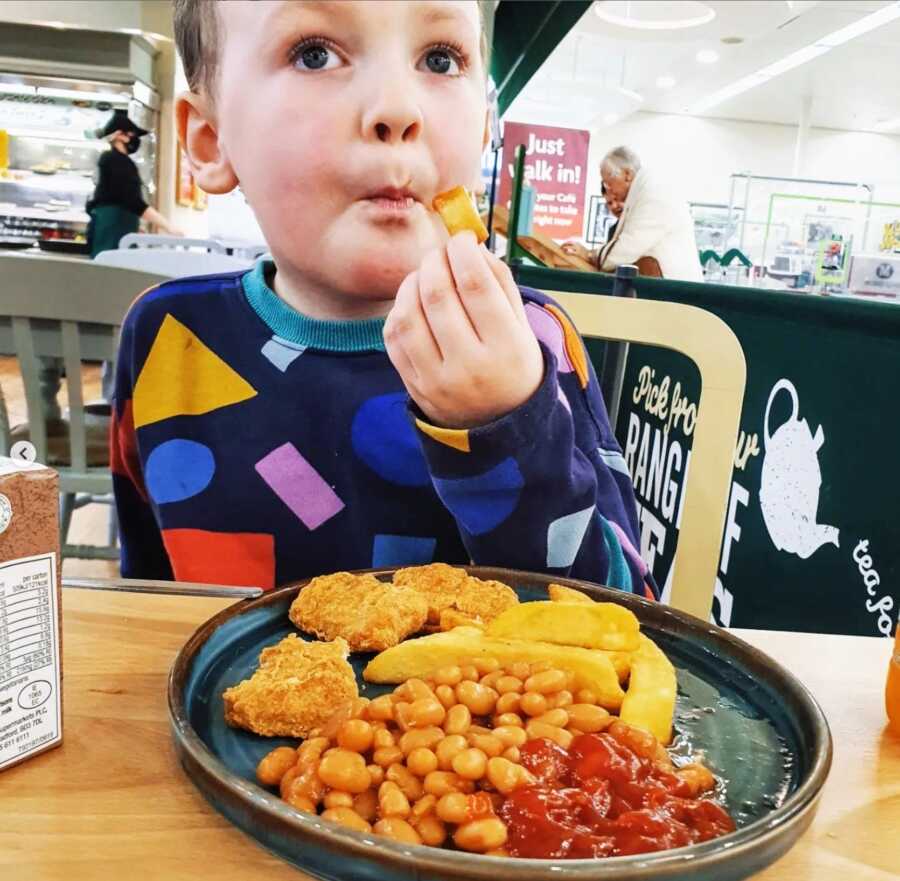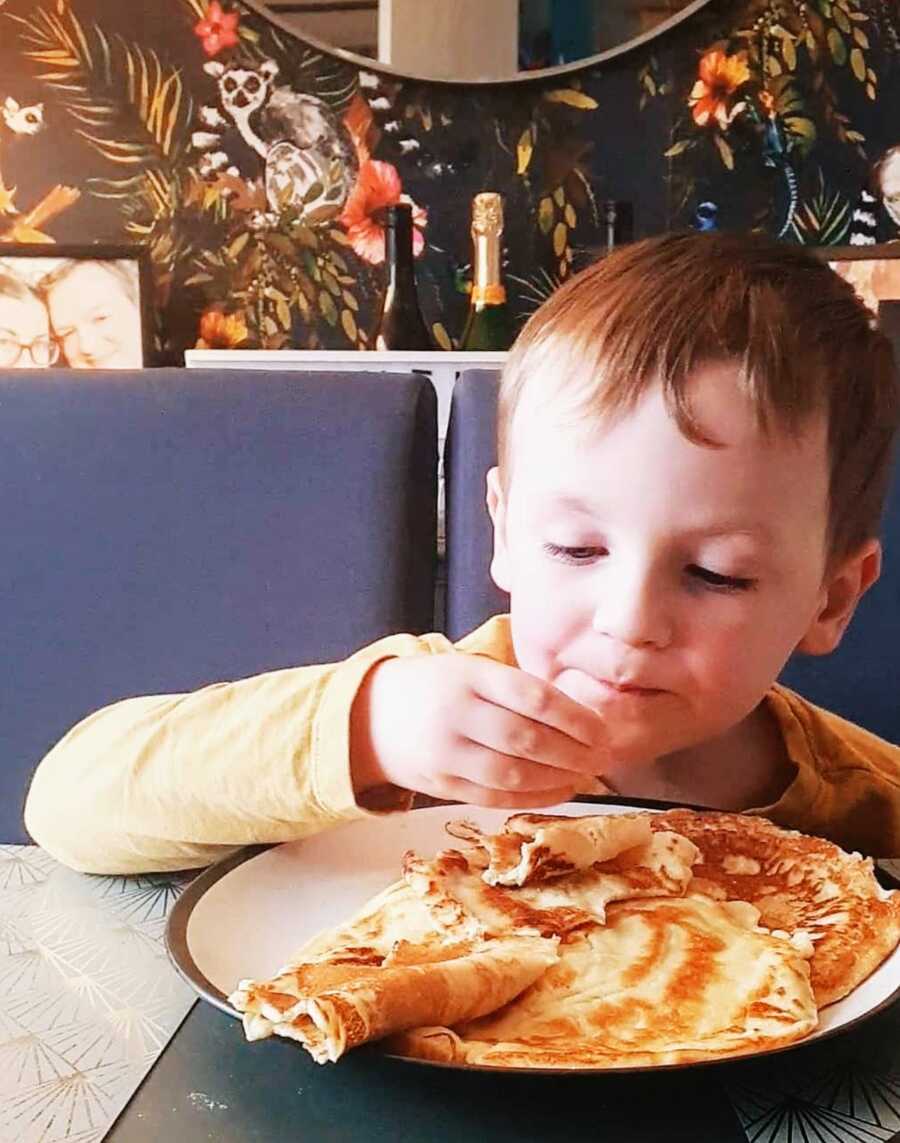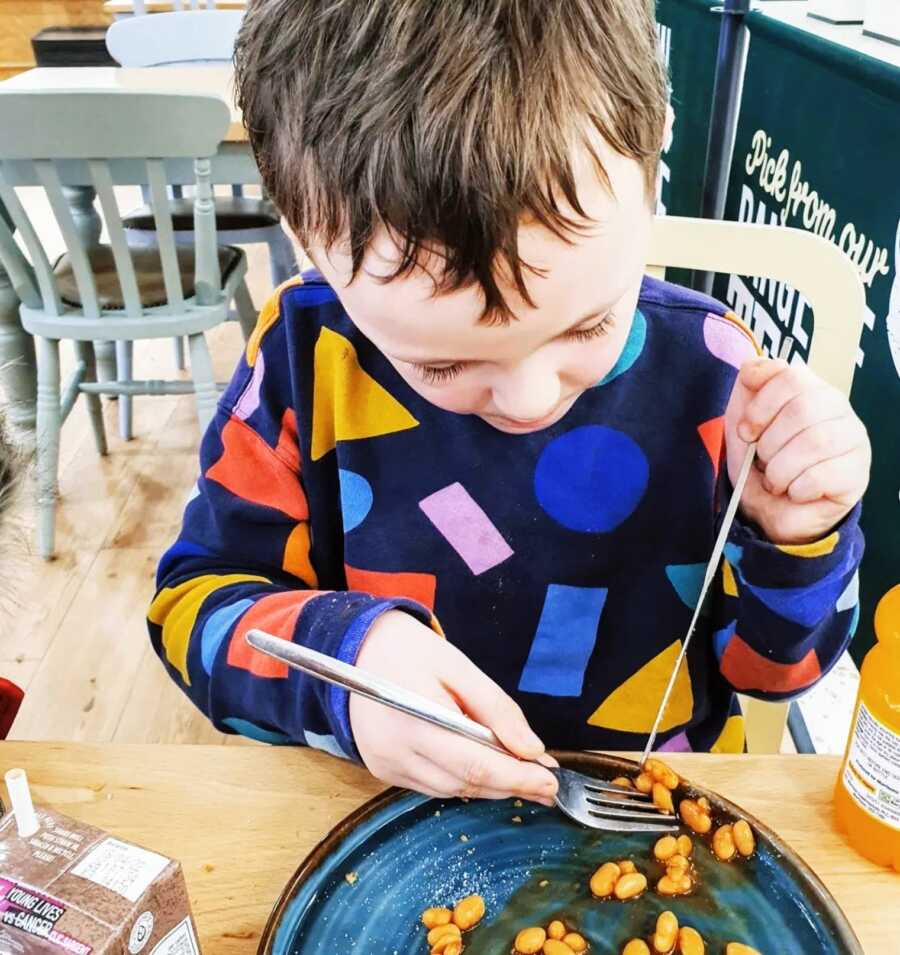My name is Katie, my husband is Toby, and we have a gorgeous little boy called Max.
We’re a loud, “fizzy,” content little neurodiverse family unit living in the UK, and we have a lot of lived experience when it comes to the concept of “same/safe” foods, so we’re really pleased to share some (hopefully) helpful tips with you all.
*Please note—we use identity-first language rather than person-first (autistic rather than “has/with autism.” Numerous case studies show a strong preference for identity-first in the autistic community, but if you prefer person-first, that’s fine. I wanted to say this in case anyone became offended.*
Our Max is a ray of sunshine and an absolute whirlwind! He is awesomely autistic and also has Global Developmental Delay and two separate speech conditions. I’m also formally diagnosed as autistic, and my husband is on the adult waiting list—he has other diagnosed relatives too. We present very differently, with different types of support needs and comorbid conditions, like a beautiful rainbow tapestry of vivid colors. Max definitely needs a lot more support than us, which makes sense, as he also has comorbidities that we don’t. I’d be lying if I said it’s been an easy road, but we’ve learned so much about our incredible little boy, neurodiversity, and advocating for equity. Now, we like to support other parents who are at the very start of the diagnosis journey.
Since I started sharing our experiences with life as a neurodiverse family on social media (find me on Instagram at @madness.to.the.max), I’ve been inundated with comments and messages from parents of autistic children who are concerned: is my child getting what they need? Will they grow well? What can I do to help? We’re so grateful to have been given the opportunity to share a write-up of our top tips!
 Courtesy of Katie Hodgkins How can autism impact someone’s relationship with food?
Courtesy of Katie Hodgkins How can autism impact someone’s relationship with food?
To put a very complex answer more simply—it varies. Very commonly, autistic people can have sensory aversions causing problems with their eating. Textures, tastes, smells; there can be many reasons. Less commonly, it can be caused by a comorbid condition known as ARFID – Avoidant Restrictive Food Intake Disorder, but this is quite extreme, more so than seeming to strongly rely upon same/safe foods, and it’s also under-recognized.
Problems with food and a reliance on same foods is something that doesn’t just affect autistic people, but it does tend to be more predominant with us, and it comes down to things that are linked to autism, like sensory aversions. This leads me to Sensory Processing Disorder—here in the UK, many diagnosticians don’t yet recognize it as a distinct condition but more an inclusive trait of autism, but this is a whole new article. Many autistic people have sensory issues with food, with or without an additional diagnosis of SPD. Many people with an SPD diagnosis, without an autism diagnosis, struggle with food too!
What are same/safe foods?
I’d say a really concise explanation of these foods is “foods that are reliable.” Foods that are always the same. Foods that we can trust to be “uniform”—no surprises, no unexpected variations. Foods that fit in with the autistic desire for routine and foods that help us to regulate and be our happy, sparkly selves.
One image that circulates online, for me, is the best summary around and can actually be applied to all children to some degree, but more profoundly and noticeably in autistic people who rely upon “same foods.” The image shows four example images of two foods—one is a berry, which comes in four different flavors, shapes, sizes, and textures. The other is a cracker, which is the same thing every time. That consistency is what makes foods like this so appealing to autistic people who rely on “same foods.”
Max in particular has a small group of selective “safe foods”: potato waffles, baked beans, and various forms of breaded protein being the main three. They’re reliably uniform in taste, texture, and smell; they’re predictable; and he can “trust” that when he takes a bite, he won’t run into any unexpected sensory input.
Quite often, if we have to change the brand if our usual brand isn’t available, Max is prone to gagging, heaving, choking and vomiting at the dinner table if he’s not coping with even a slight deviation in what he is used to, which is really tricky as of course, this can be risky!
So, with that background laid out, here are my top tips!
 Courtesy of Katie Hodgkins Understand that your child or autistic friend isn’t deliberately being “fussy” or “picky,” and don’t think that it’s personal!
Courtesy of Katie Hodgkins Understand that your child or autistic friend isn’t deliberately being “fussy” or “picky,” and don’t think that it’s personal!
Don’t worry—that delicious meal that you spent so much time lovingly preparing, cooking, and serving is perfect. It’s nothing personal—there could be so many reasons why an autistic person is a restrictive eater and unable to tuck into your cooking. Textures, smells, overwhelming tastes, the environment…it varies on the individual.
I’ll also take the opportunity here to briefly mention sensory seekers and how this impacts their eating. Sensory seekers (I’m definitely one of them) who are particularly sensory seeking with their olfactory senses can tend to seek out strong flavors and very specific textures such as extremely crunchy foods for example, and then struggle to be motivated by non-stimulatory foods. Thus, they only eat their “same foods,” as they need the sensory input.
It isn’t as simple as just being a ‘fussy eater’…
Many of us parents will have been chastised about not being “strict” enough and are even accused of “creating a problem” which is unfair really—do people think we wouldn’t love our child to sit down and eat a plate of colorful vegetables happily?! Sensory aversions can actually be incredibly distressing, at times even painful—it’s so much more than mere pickiness.
It isn’t boundary-pushing either—as developmentally normal as this is in ALL children at some stage—but you’ll be able to tell. If they refused their dinner and then slyly begged for ice cream, THIS may border on “boundary-pushing.” If they had a meltdown (which is not the same as a typical tantrum) or exhibited other behaviors that you know mean they’re overwhelmed and not okay, then you know! Your child isn’t deliberately setting out to test you or behaving badly, they’re struggling and may not be able to explain this to you.
 Courtesy of Katie Hodgkins Pick Your Battles and Take it Slowly
Courtesy of Katie Hodgkins Pick Your Battles and Take it Slowly
Forcing an autistic person with food aversions and a reliance on same/safe foods to eat things they struggle with, with the threat of “go hungry,” isn’t the way to go about it, especially if that person also has communication difficulties and isn’t able to explain to you. Imagine not being able to tell someone what is bothering you and being left hungry and sad!
Some more “old school” parents might disagree, but doing this does not take into account WHY a certain food is a problem, doesn’t take your child’s comfort into account, and if it’s a sensory problem, it can actually be truly painful in a way that you don’t understand for a child to have a specific texture or flavor flooding their senses. It isn’t “giving in” or letting them “rule the roost” to pick your battles and ensure they have a full belly. Even if this is chicken nuggets…
There are ways to adapt a diet filled with same/safe foods that aren’t particularly nutrient-dense. There can be disagreement on whether it’s ethical to sneak healthy things into food without saying, so I won’t poke that wasp’s nest of differing stances. For us, we give Max a daily gummy multivitamin that looks like a sweet/candy and tell him, “This will make you grow big and strong.” We also involve him in cooking as much as possible and talk about the positives: nice smells, lovely colors, and encouraging tastes, but we never coerce him and gently introduce new things incrementally. This has been a fun way to get him to nibble strawberries, lettuce, and other healthy foods on his own terms!
Always Be Prepared
Parents of autistic children and autistic adults will know the struggle of our foods going out of stock due to a recall, shortage, or even a change of packaging or recipe. You’ll be surprised what a change in packaging can cause if you’re new to our world! Here in the UK, we had a Walkers crisps (Lays for you US readers) shortage which caused an uproar in the autism community. A popular kids’ drink called “Fruit Shoots” also changed their bottles to translucent plastic as the new material is 100% recycled…much to the displeasure of neurodiverse people across the UK. An unexpected change in same/safe foods can really be catastrophic!
My biggest tips here are to stock up in bulk to be safe (yay for Costco memberships) and look for the closest possible alternative as often as possible in the hope that it’s also enjoyable as a back-up. Another good tip would be to ask around when things are out of stock—you’ll be surprised by how compassionate people can be. Local Facebook groups, other social media platforms, and even the PR contacts at the manufacturers and retailers could be able to help you out if you get in touch.
Look into other contributing factors
Look into possible PHYSICAL problems causing the aversion to certain foods and reliance on same/safe foods—enlarged tonsils, dysphagia, hypermobility or low tone (or both) in hands and fingers making it hard to grip cutlery meaning a finger food may be a safe option…there are so many possibilities. GI problems like reflux are another consideration, especially if someone had these issues earlier in life and has developed an association! A good example would be that Max had severe GERD due to CMPA as a baby which put him off all types of milk until he was at least three.
Bear in mind that hypermobility and Ehlers Danlos Syndrome are comorbid with autism, and these can contribute to fine motor and digestive issues! I have Ehlers Danlos Syndrome, and Max is showing some signs, but it’s a little too early to know. Depending on how an autistic person presents and what comorbidities they have, they may struggle to share these or explain them to you, so it’s a case of trial and error and, of course, consulting with medical professionals.
 Courtesy of Katie Hodgkins Stay Positive
Courtesy of Katie Hodgkins Stay Positive
Our pediatrician is a breath of fresh air and talked me down when I was stressing over Max’s diet. His iron levels and other vitamin levels have been checked, and she has no concerns, as long as he’s eating enough to grow and develop, with care taken to ensure he gets what he needs. She was particularly pleased that he’s able to take a daily multivitamin too.
Will Max be tucking into my elaborate dishes filled with multiple vegetables, herbs, spices, and textures any time soon? Perhaps not. But he’s in excellent physical health, growing, thriving, and bouncing off the walls from dawn ’til dusk, so clearly he’s well-fueled and content. If you’re worried about deficiencies, speak to your doctor, as they can check this out and assure you, and if they refer you to a dietician or feeding specialist, definitely check that they’re experienced with neurodiverse kids!
Research what support you could get
A lot of countries have financial support available to eligible families—here in the UK, we have Disability Living Allowance (which turns to Personal Independence Payment upon adulthood) at different levels, depending on the type of care needed. This financial support is intended to help families with the additional costs that can often come when you have a child with additional care needs: meltdowns that result in broken televisions, time off work for more medical appointments, sensory toys, private speech therapy, and even to allay the additional costs when it comes to grocery shopping if your awesome autistic relative’s safe food is an expensive branded product and, try as you might, a cheaper alternative is a no-go.
Sometimes, these routes of financial support are stigmatized, usually by people who just don’t “get it,” but my advice here is that there is absolutely no shame in accessing the support that is available out there. It’s there for a reason!
In conclusion…
This is such a multifaceted topic, and I can’t pretend to be an authority on the matter, even as a parent of an autistic child and an autistic adult myself—we’re all so different, but many of us share this particular “hurdle.” All I can do is share our lived experience, some advice that I hope will help you, and some assurance that as long as you’re doing your best, you’re doing a wonderful job.
I hope that this was an informative read for those of you new to the concept of same/safe food, and for those of you who’ve shared this to quell ignorant comments about your parenting—you’re doing a fabulous job, you’re a great parent, you are SEEN. For more insight into the life of a neurodiverse family unit, follow me at @madness.to.the.max on Instagram, I’m looking forward to meeting you!
 Courtesy of Katie Hodgkins
Courtesy of Katie Hodgkins
This story was submitted to Love What Matters by Katie Hodgkins. You can follow her journey on Instagram. Submit your own story here. Be sure to subscribe to our free email newsletter for our best stories, and YouTube for our best videos.
Read more stories like this here:
‘My name is Cooper. I have autism and am nonverbal, but I still LOVE CANDY! TRICK-OR-TREAT.’: Mom pushes for inclusive Halloween, ‘Please be patient’
The Day I Was Diagnosed As Autistic Was The Day I Became ‘Normal’
‘I was lying in bed, feeling extreme anxiety about a noise I heard, when it hit me like a ton of bricks. ‘I HAVE IT, TOO.’: Mom learns she’s lived 34 years with Sensory Processing Disorder after daughter’s diagnosis
‘This is who they are supposed to be.’: Mom opens up about accepting her 3 kids’ autism diagnoses
Do you know someone who could benefit from reading this? SHARE this story on Facebook with family and friends.
121 Shares Tweet Email autism, autistic adult, autistic child, autistic mom, safe foods, same fooding, same foods, sensory processing disorder 45-Year-Old Births Surprise Daughter, And This Video Showing Her Bond With Adult Brothers Will Melt Your HeartWhy You Should Stop Telling Your Loves Ones “Time Will Heal” Their Grief
Source: lovewhatmatters.com








